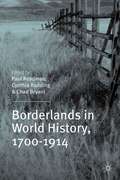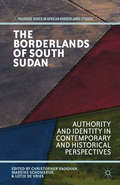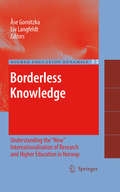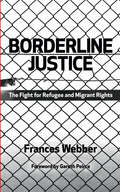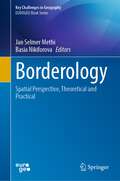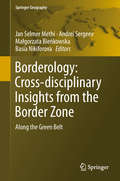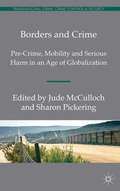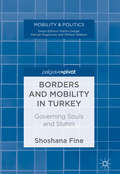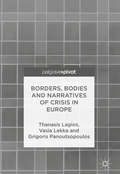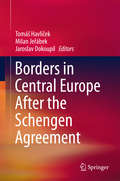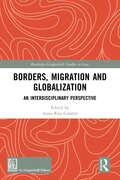- Table View
- List View
Borderlands in World History, 1700-1914
by Cynthia Radding Chad Bryant Paul ReadmanCovering two hundred years, this groundbreaking book brings together essays on borderlands by leading experts in the modern history of the Americas, Europe, Africa, Asia and Australia to offer the first historical study of borderlands with a global reach.
The Borderlands of South Sudan: Authority and Identity in Contemporary and Historical Perspectives (Palgrave Series in African Borderlands Studies)
by Christopher Vaughan, Mareike Schomerus, and Lotje de VriesMoving beyond the current fixation on "state construction," the interdisciplinary work gathered here explores regulatory authority in South Sudan's borderlands from both contemporary and historical perspectives. Taken together, these studies show how emerging governance practices challenge the bounded categorizations of "state" and "non-state."
Borderless Knowledge: Understanding the "New" Internationalisation of Research and Higher Education in Norway (Higher Education Dynamics #22)
by Liv Langfeldt Ase GornitzkaProcesses of knowledge production and dissemination are increasingly set in an international context. In research and higher education the links between local actors and the international environments are both proliferating and intensifying. Individual level self-organised international collaboration is increasingly supplemented by national and supranational organised activities, and by market oriented activity with a global scope. Starting from these observations, this book analyses patterns of internationalisation comprising the national and supranational level, the level of higher education institutions and private companies, as well as the level of individual researchers and graduates. As a laboratory for studying internationalisation the book uses the case of Norway, a small knowledge system set in an open society, political system and economy. The case offers exceptionally good data on the developments in its research and higher education system that record changes over time and across the different parts and levels of a national knowledge system
Borderline Justice: The Fight for Refugee and Migrant Rights
by Frances WebberBorderline Justice describes the exclusionary policies, inhumane decisions and obstacles to justice for refugees and migrants in the British legal system.*BR**BR*Frances Webber, a long-standing legal practitioner, reveals how the law has been (mis)applied to migrants, refugees and other ‘unpopular minorities’. This book records some of the key legal struggles of the past thirty years which have sought to preserve values of universality in human rights - and the importance of continuing to fight for those values, inside and outside the courtroom. *BR**BR*The themes and analysis cross boundaries of law, politics, sociology, criminology, refugee studies and terrorism studies, appealing to the radical tradition in all these disciplines.
Borderline Justice: The Fight for Refugee and Migrant Rights
by Frances WebberBorderline Justice describes the exclusionary policies, inhumane decisions and obstacles to justice for refugees and migrants in the British legal system.*BR**BR*Frances Webber, a long-standing legal practitioner, reveals how the law has been (mis)applied to migrants, refugees and other ‘unpopular minorities’. This book records some of the key legal struggles of the past thirty years which have sought to preserve values of universality in human rights - and the importance of continuing to fight for those values, inside and outside the courtroom. *BR**BR*The themes and analysis cross boundaries of law, politics, sociology, criminology, refugee studies and terrorism studies, appealing to the radical tradition in all these disciplines.
Borderlines: A History of Europe, Told From the Edges
by Lewis Baston'Thrillingly unique, knowledgeable, perceptive and profound' IAN DUNT'A light-footed journey along the fault lines of history.' KATJA HOYERThe history of Europe told through twenty-nine key borders that define the past, present and future of our continentEurope's internal borders have rarely been 'natural'; they have more often been created by accident or force.In Borderlines, political historian Lewis Baston journeys along twenty-nine key borders from west to east Europe, examining how the map of our continent has been redrawn over the last century, with varying degrees of success. The fingerprints of Napoleon, Alexander I, Castlereagh, Napoleon III and Bismarck are all there, but today's map of Europe is mostly the work of the Allies in 1919 and Stalin in 1945.To journey to the centre of the story of Europe, Baston takes us to its edges, bringing to life the fascinating and often bizarre histories of these border zones. We visit Baarle, the town broken into thirty fragments by the Netherland-Belgium border, and stop in Ostritz, the eastern German town where Nazis held a rock festival. We meander the back lanes of rural Ireland, and soak up the atmosphere in the coffee houses of the Ukrainian city of Chernivtsi. Through these borderlands, Baston explores how places and people heal from the scars left by a Europe of ethnic cleansing and barbed wire fences, and he searches for a better European future - finding it in unexpected places.'Extraordinarily perceptive and original' ANTHONY SELDON'Refreshing and important' RAFAEL BEHR
Borderology: Spatial Perspective, Theoretical and Practical (Key Challenges in Geography)
by Jan Selmer Methi Basia NikiforovaThis book develops and establishes knowledge about borderology in the border zone between different countries, cultures, and climatic environment. The content of border and border zone has, during our research, changed from being a physical border between states to different borders and border zones which also include social and mental borders. The COVID-19 pandemic has challenged the concept even more. The expressions “lockdown” and "social distance" indicate such borders that we, a short time ago, had largely not considered in our everyday life. Not only states closed their borders, regions inside a country, and even borders within families were established. “Illegally” passing these borders could crate strong reactions both from the nature by a disease or by the authorities with fees. The pandemic has not only challenged our understanding of borders and border zones, but it has also challenged our understanding of human rights and especially our understanding of what freedom is.
Borderology: Along the Green Belt (Springer Geography)
by Jan Selmer Methi Andrei Sergeev Małgorzata Bieńkowska Basia NikiforovaThis book provides a unique and multifaceted view on and understanding of borders and their manifestations: physical and mental, cultural and geographical, and as a question of life and death. It highlights the Green Belt along the Iron Curtain, which offered a haven for rare species for many decades and, after the Cold War, became a veritable treasure trove for a European network of researchers. A geographical border is something that can be seen, but other borders sometimes have to be crossed to be discovered. The border zone is an arena for development that is not found in any other places. This book focuses on borderology, which became the name of a cross-border study and research program that explores the border zone from multiple perspectives. This cross-disciplinary book will appeal to interested researchers and students from many fields, from philosophy and diplomacy to ecology and geography.
Borders among Activists: International NGOs in the United States, Britain, and France
by Sarah S. StroupIn Borders among Activists, Sarah S. Stroup challenges the notion that political activism has gone beyond borders and created a global or transnational civil society. Instead, at the most globally active, purportedly cosmopolitan groups in the world—international nongovernmental organizations (INGOs)—organizational practices are deeply tied to national environments, creating great diversity in the way these groups organize themselves, engage in advocacy, and deliver services.Stroup offers detailed profiles of these "varieties of activism" in the United States, Britain, and France. These three countries are the most popular bases for INGOs, but each provides a very different environment for charitable organizations due to differences in legal regulations, political opportunities, resources, and patterns of social networks. Stroup’s comparisons of leading American, British, and French INGOs—Care, Oxfam, Médecins sans Frontières, Human Rights Watch, Amnesty International, and Fédération Internationale des ligues des Droits de l'Homme—reveal strong national patterns in INGO practices, including advocacy, fund-raising, and professionalization. These differences are quite pronounced among INGOs in the humanitarian relief sector and are observable, though less marked, among human rights INGOs. Stroup finds that national origin helps account for variation in the "transnational advocacy networks" that have received so much attention in international relations. For practitioners, national origin offers an alternative explanation for the frequently lamented failures of INGOs in the field: INGOs are not inherently dysfunctional, but instead remain disconnected because of their strong roots in very different national environments.
Borders and Belonging: A Memoir
by Mira SucharovIn this gripping and honest memoir, Mira Sucharov shows what a search for political and emotional home looks like. Sucharov suffered from childhood phobias triggered by her parents’ divorce, and she sought emotional refuge in Jewish summer camp. But three years spent living in Israel in her twenties shook her to her core. Ultimately, encounters with colleagues, students, friends and lovers force her to confront what it means to be able to write, advocate and teach about Israel/Palestine in a way that balances affirmation with authenticity.
Borders and Crime: Pre-Crime, Mobility and Serious Harm in an Age of Globalization (Transnational Crime, Crime Control and Security)
by Jude McCulloch and Sharon PickeringThe collection considers the growing importance of the border as a prime site for criminal justice activity and explores the impact of border policing on human rights and global justice. It covers a range of subjects from e-trafficking, child soldiers, the 'global war on terror' in Africa and police activities that generate crime.
Borders and Mobility in Turkey: Governing Souls and States
by Shoshana FineIn the last two decades, Turkey has witnessed a variety of bordering interventions rooted in its problematisation as variously "transit," "destination," "European," "Muslim" and "safe." This book brings into focus seemingly disparate actors involved in such interventions, from the EU and international organisations to missionaries, security professionals and migrants themselves. It exposes how these actors depend upon the intersecting rationalities of managerialism, securitisation, humanitarianism and orientalism to control, contain, process, save and soul-lift mobile populations.
Borders and Mobility in Turkey: Governing Souls and States
by Shoshana FineIn the last two decades, Turkey has witnessed a variety of bordering interventions rooted in its problematisation as variously "transit," "destination," "European," "Muslim" and "safe." This book brings into focus seemingly disparate actors involved in such interventions, from the EU and international organisations to missionaries, security professionals and migrants themselves. It exposes how these actors depend upon the intersecting rationalities of managerialism, securitisation, humanitarianism and orientalism to control, contain, process, save and soul-lift mobile populations.
Borders, Bodies and Narratives of Crisis in Europe
by Thanasis Lagios Vasia Lekka Grigoris PanoutsopoulosThis book addresses two interrelated discourses of crisis in contemporary Europe: the migrant crisis vs. the economic crisis. The chapters shed light on the thread that links these two issues by first examining immigration and the transformations regarding its control and administration via border technologies, as well as on the centrality of the body as a means and carrier of border within contemporary biopolitical societies. In a second step, the authors proceed to a genealogy of the current discourses regarding the financial and political crisis through a Foucauldian and Lacanian perspective, focusing on the co-articulation of scientific knowledge and biopolitical power in Western societies.
Borders, Fences and Walls: State of Insecurity? (Border Regions Series)
by Elisabeth ValletTwenty years after the fall of the Berlin Wall, the question remains ’Do good fences still make good neighbours’? Since the Great Wall of China, the Antonine Wall, built in Scotland to support Hadrian's Wall, the Roman ’Limes’ or the Danevirk fence, the ’wall’ has been a constant in the protection of defined entities claiming sovereignty, East and West. But is the wall more than an historical relict for the management of borders? In recent years, the wall has been given renewed vigour in North America, particularly along the U.S.-Mexico border, and in Israel-Palestine. But the success of these new walls in the development of friendly and orderly relations between nations (or indeed, within nations) remains unclear. What role does the wall play in the development of security and insecurity? Do walls contribute to a sense of insecurity as much as they assuage fears and create a sense of security for those 'behind the line'? Exactly what kind of security is associated with border walls? This book explores the issue of how the return of the border fences and walls as a political tool may be symptomatic of a new era in border studies and international relations. Taking a multidisciplinary approach, this volume examines problems that include security issues ; the recurrence and/or decline of the wall; wall discourses ; legal approaches to the wall; the ’wall industry’ and border technology, as well as their symbolism, role, objectives and efficiency.
Borders, Fences and Walls: State of Insecurity? (Border Regions Series)
by Elisabeth ValletTwenty years after the fall of the Berlin Wall, the question remains ’Do good fences still make good neighbours’? Since the Great Wall of China, the Antonine Wall, built in Scotland to support Hadrian's Wall, the Roman ’Limes’ or the Danevirk fence, the ’wall’ has been a constant in the protection of defined entities claiming sovereignty, East and West. But is the wall more than an historical relict for the management of borders? In recent years, the wall has been given renewed vigour in North America, particularly along the U.S.-Mexico border, and in Israel-Palestine. But the success of these new walls in the development of friendly and orderly relations between nations (or indeed, within nations) remains unclear. What role does the wall play in the development of security and insecurity? Do walls contribute to a sense of insecurity as much as they assuage fears and create a sense of security for those 'behind the line'? Exactly what kind of security is associated with border walls? This book explores the issue of how the return of the border fences and walls as a political tool may be symptomatic of a new era in border studies and international relations. Taking a multidisciplinary approach, this volume examines problems that include security issues ; the recurrence and/or decline of the wall; wall discourses ; legal approaches to the wall; the ’wall industry’ and border technology, as well as their symbolism, role, objectives and efficiency.
Borders in Central Europe After the Schengen Agreement
by Tomáš Havlíček Milan Jeřábek Jaroslav DokoupilThis book is the result of research into the considerable impacts the signing of the Schengen Agreement has had on the border regions of the signatory, in particular the Central European internal borders. The analysis provides an in-depth look at European integration, development and perception at the state level as well as in the selected border regions of Central Europe. The book discusses results from population questionnaires in this region, and presents the most important features of development of border regions within Central European internal borders/borderlands after the Schengen Agreement. This book is suitable for students and researchers dealing with the borderlands, but also outlines sufficient information to be of interest to regional planners and policy makers.
Borders in Post-Socialist Europe: Territory, Scale, Society
by Tassilo Herrschel'Borders' have attracted considerable attention in public and academic debates in light of the impact of globalisation and, in Europe, the end of the divisions of the Cold War era. Instead, being inside or outside of the EU has become a major paradigmatic divide between claimed 'spheres of influence' by 'Brussels' and 'Moscow' respectively. In the aftermath of the end of communism, established certainties no longer seemed to apply. And this included many of the borders within the former eastern Bloc, with some losing their relevance, while others re-assert themselves. As its particular contribution, this book adopts a symbiotic approach to the analysis of borders, drawing on a political-economy perspective, while also recognising the importance of the socio-cultural dimension as found in 'border studies'. This seeks to do greater justice to the complex, composite nature of borders as geo-political, state-legal and cultural-historic constructs in both theory and practice. In addition, the book's approach stretches across spatial scales to capture the multi-level nature of borders. The first part of the book presents the conceptual framework as it sets out to embrace this multi-faceted, multi-layered nature of borders. In the second part, case studies from north-central Europe, including the Baltic Sea Region, exemplify the complexity of borders in the context of post-socialist transformation and continuing EU-isation.
Borders in Post-Socialist Europe: Territory, Scale, Society (Border Regions Ser.)
by Tassilo Herrschel'Borders' have attracted considerable attention in public and academic debates in light of the impact of globalisation and, in Europe, the end of the divisions of the Cold War era. Instead, being inside or outside of the EU has become a major paradigmatic divide between claimed 'spheres of influence' by 'Brussels' and 'Moscow' respectively. In the aftermath of the end of communism, established certainties no longer seemed to apply. And this included many of the borders within the former eastern Bloc, with some losing their relevance, while others re-assert themselves. As its particular contribution, this book adopts a symbiotic approach to the analysis of borders, drawing on a political-economy perspective, while also recognising the importance of the socio-cultural dimension as found in 'border studies'. This seeks to do greater justice to the complex, composite nature of borders as geo-political, state-legal and cultural-historic constructs in both theory and practice. In addition, the book's approach stretches across spatial scales to capture the multi-level nature of borders. The first part of the book presents the conceptual framework as it sets out to embrace this multi-faceted, multi-layered nature of borders. In the second part, case studies from north-central Europe, including the Baltic Sea Region, exemplify the complexity of borders in the context of post-socialist transformation and continuing EU-isation.
Borders in the Baltic Sea Region: Suturing the Ruptures
by Andrey Makarychev and Alexandra YatsykThis book focuses on the recent political trajectories within the Baltic Sea Region from one of the success stories of regionalism in Europe to a potential area of military confrontation between Russia and NATO. The authors closely examine the following issues: new security challenges for the region stemming from Russia’s staunch anti-EU and anti-NATO polices, institutions and practices of multi-level governance in the region, and different cultural strategies that regional actors employ. The common threads of this innovative volume are issues of changing borders and boundaries in the region, and logics of inclusion and exclusion that shape its political contours. From diverse disciplinary and methodological positions the authors explain policies of specific Baltic Sea states, as well as structural matters that make them a region.
Borders, Migration and Class in an Age of Crisis: Producing Immigrants and Workers (Global migration and social change)
by Tom VickersThis book responds to global tendencies toward increasingly restrictive border controls and populist movements targeting migrants for violence and exclusion. Informed by Marxist theory, it challenges standard narratives about immigration and problematises commonplace distinctions between ‘migrants’ and ‘workers’. Using Britain as a case study, the book examines how these categories have been constructed and mobilised within representations of a ‘migrant crisis’ and a ‘welfare crisis’ to facilitate capitalist exploitation. It uses ideas from grassroots activism to propose alternative understandings of the relationship between borders, migration and class that provide a basis for solidarity.
Borders, Migration and Class in an Age of Crisis: Producing Immigrants and Workers (Global migration and social change)
by Tom VickersThis book responds to global tendencies toward increasingly restrictive border controls and populist movements targeting migrants for violence and exclusion. Informed by Marxist theory, it challenges standard narratives about immigration and problematises commonplace distinctions between ‘migrants’ and ‘workers’. Using Britain as a case study, the book examines how these categories have been constructed and mobilised within representations of a ‘migrant crisis’ and a ‘welfare crisis’ to facilitate capitalist exploitation. It uses ideas from grassroots activism to propose alternative understandings of the relationship between borders, migration and class that provide a basis for solidarity.
Borders, Migration and Globalization: An Interdisciplinary Perspective (Routledge-Giappichelli Studies in Law)
by Anna Rita CalabròThe emergence of new and substantial human migration flows is one of the most important consequences of globalisation. While ascribable to widely differing social and economic causes, from the forced migration of refugees to upper-middle-class migration projects and the movement of highly skilled workers, what they have in common is the effect of contributing to a substantial global redefinition in terms of both identity and politics. This book contains contributions from scholars in the fields of law, social sciences, the sciences, and the liberal arts, brought together to delineate the features of the migration phenomena that will accompany us over the coming decades. The focus is on the multifaceted concept of 'border' as representing a useful stratagem for dealing with a topic like migration that requires analysis from several perspectives. The authors discuss the various factors and issues which must be understood in all their complexity so that they can be governed by all social stakeholders, free of manipulation and false consciousness. They bring an interdisciplinary and comparative perspective to the social phenomena such as human trafficking, unaccompanied foreign minors, or ethnic-based niches in the job market. The book will be a valuable guide for academics, students and policy-makers.
Borders, Migration and Globalization: An Interdisciplinary Perspective (Routledge-Giappichelli Studies in Law)
by Anna Rita CalabròThe emergence of new and substantial human migration flows is one of the most important consequences of globalisation. While ascribable to widely differing social and economic causes, from the forced migration of refugees to upper-middle-class migration projects and the movement of highly skilled workers, what they have in common is the effect of contributing to a substantial global redefinition in terms of both identity and politics. This book contains contributions from scholars in the fields of law, social sciences, the sciences, and the liberal arts, brought together to delineate the features of the migration phenomena that will accompany us over the coming decades. The focus is on the multifaceted concept of 'border' as representing a useful stratagem for dealing with a topic like migration that requires analysis from several perspectives. The authors discuss the various factors and issues which must be understood in all their complexity so that they can be governed by all social stakeholders, free of manipulation and false consciousness. They bring an interdisciplinary and comparative perspective to the social phenomena such as human trafficking, unaccompanied foreign minors, or ethnic-based niches in the job market. The book will be a valuable guide for academics, students and policy-makers.
Borders, mobility and belonging
by Mary Gilmartin Patricia WoodQuestions of migration and citizenship are at the heart of global political debate with Brexit and the election of Donald Trump having ripple effects around the world. Providing new insights into the politics of migration and citizenship in the UK and the US, this book challenges the increasingly prevalent view of migration and migrants as threats and of formal citizenship as a necessary marker of belonging. Instead the authors offer an analysis of migration and citizenship in practice, as a counterpoint to simplistic discourses. The book uses cutting-edge academic work on migration and citizenship to address three themes central to current debates – borders and walls, mobility and travel, and belonging. Through this analysis a clearer picture of the roots of these politics emerges as well as of the consequences for mobility, political participation and belonging in the 21st century.
